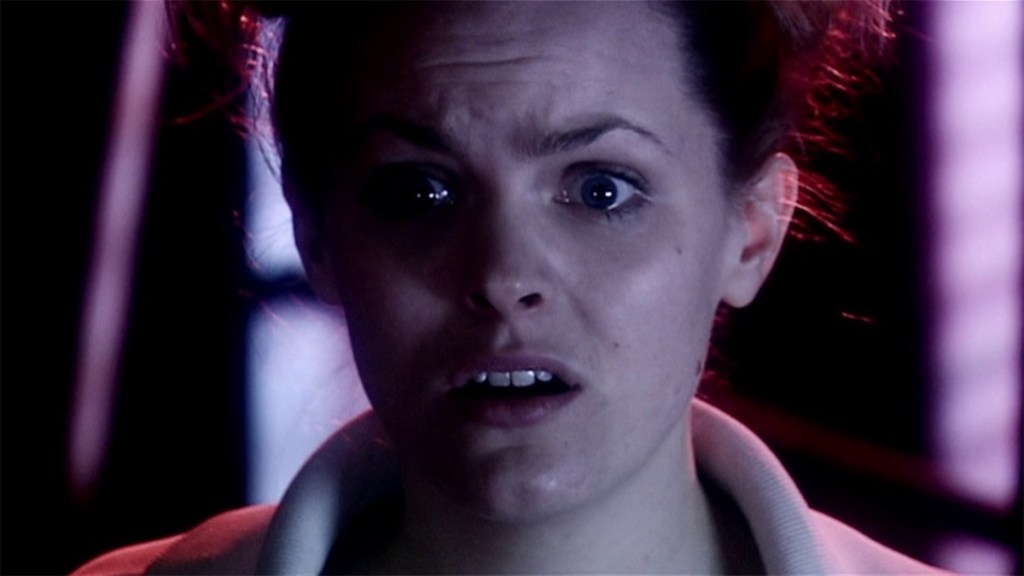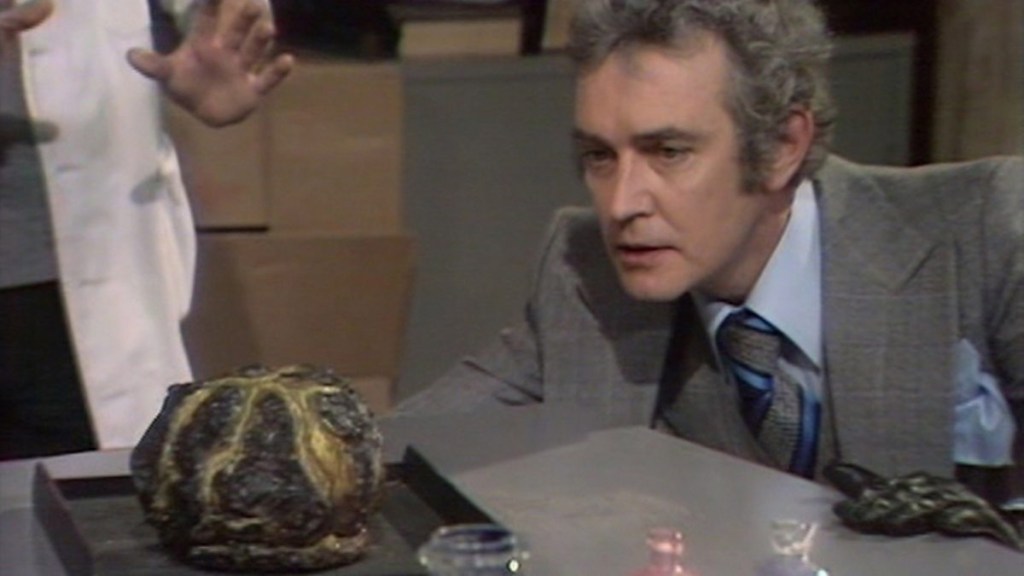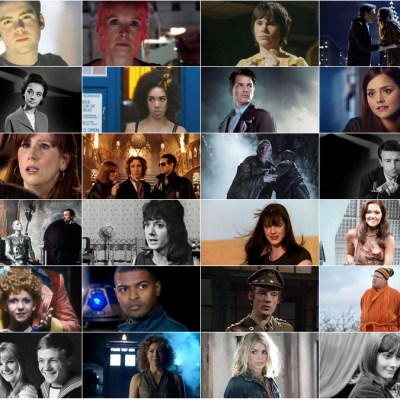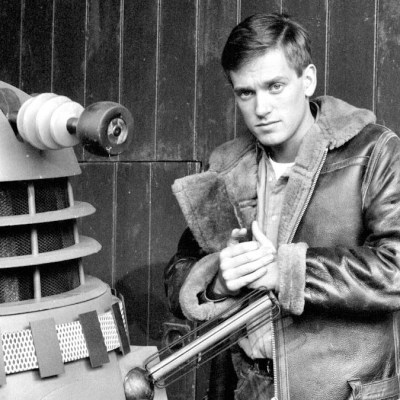Some Doctor Who characters are intended for greatness; some are intended to be killed off at the end of their first episode. Writers have a lot more control over the second than the first. What remains true for all characters, is the tension that exists between their function in the story and their potential to affect it. Even a guard who simply runs into a room to get shot could have dragged the story in another direction, should they be allowed (this stock background character was the inspiration for Terry Pratchett’s City Watch novels).
Successful one-off characters aren’t necessarily those who break away from their function, (or even those who aren’t strictly required, for example Binro the Heretic in ‘The Ribos Operation’), but those who make a story soar to another level entirely. More often, what makes them work is when their function in the story is disguised. There are plenty of ways to do this and most of them intersect: casting, costume, dialogue, performance…
Let’s first address the latter. Does the actor need to get under the skin of the character to create a nuanced and layered take that resonates utterly with the audience?
Nope. Doctor Who frequently embraces camp. Sometimes camp holds Doctor Who at gunpoint and sings piano ballads at it. The results vary. Richard Briers’ possessed Chief Caretaker in ‘Paradise Towers’ undermines the production (while not a production striving for kitchen sink realism, Briers’ parody-like performance still cuts against its Brechtian leanings) whereas Graham Crowden’s Soldeed is heightened and ridiculous among similar performances.

Other great examples of this stock character, which I am calling Ham-Err Horror without apology, include Professor Zaroff in ‘The Underwater Menace’ (intended to be driven mad by the death of his family, only for this to be cut from the script, rendering the character inexplicably inexplicable) and John Lumic from ‘Rise of the Cybermen’ (inspired to create the Cybermen by a fear of death, with actor Roger Lloyd-Pack citing Dick Cheney as an inspiration for the performance, but remembered mainly for the ripe delivery of lines such as ‘And how will you do that from beyond the grave?’).
Sometimes you don’t even need dialogue. Christopher Bowen, as Mordred in ‘Battlefield’, commits to a maniacal laugh so long that there’s a cut to another scene in the middle of it.
And yet there are places where camp or over-the-top villains work unironically, and some of the most hospitable are the Tom Baker stories of 1975-1977. Harrison Chase, Magnus Greel, Morbius, the Master… these characters fit into the Grand Guignol tradition of heightened and melodramatic performances (Just because something is dark and morbid doesn’t stop it being ludicrously tragic). As the tone of these stories is pitched at gothic melodrama though, the characters and setting cohere.
Returning to ‘Battlefield’, while there are some great individual performances from one-off characters, they’re not quite pulling in the same direction (Jean Marsh as Morgaine is playing an inter-dimensional sorceress as if it’s real, Marcus Gilbert as Ancelyn is saying ‘This is ridiculous, and that’s great’ and pulling along Angela Bruce’s Bambera in that direction too). ‘Battlefield’ is fun, but also disjointed.
Read more
Some characters get by on the strength of costume or make-up, such as the Destroyer (also from ‘Battlefield’) or the Zygons. Broton, the latter’s leader, is a successful character who operates purely as a function rather than an individual. Played with haughty relish by John Woodnutt, Broton is a visual triumph, with the costume a collaboration between costume designer Jim Acheson, visual effects designer John Friedlander and director Douglas Camfield. At its best, ‘Terror of the Zygons’ oozes with tension and atmosphere, with some fantastic design work and enjoyable pulp runaround. This all distracts the viewer from Broton being a colossal idiot. Indulging in clichés such as explaining his entire plot, putting characters in easily escapable situations and assuming the Doctor is dead without proof, Broton has to do these for the story to unfold according to Doctor Who’s format. Fortunately few people watch ‘Terror of the Zygons’ for Broton’s unique take on planetary subjugation.
Some clichés exist specifically because that character has worked well in previous stories. Frequently in Doctor Who somebody would sacrifice themselves to save the day, someone else would comment on this, and everybody would look solemn for a few seconds before immediately moving on with their lives. ‘The Ark in Space’ features two people sacrificing themselves to save humanity, one with a quip about his union and the other fighting possession, and in 1975, a single line noting these acts was enough.

In 2005, TV had changed, and so Doctor Who threw more weight behind these deaths (boosted by Russell T. Davies’ seemingly effortless ability to generate a whole human life by adding three adjectives per character to the scripts). Jabe in ‘The End of the World’, Gwyneth in ‘An Unquiet Dead’, Pete Tyler in ‘Father’s Day’… these sacrifices were dwelt on, their weight became cumulative. From this, a subgenre of Almost Companions emerged with Lynda in ‘The Parting of the Ways’, Astrid in ‘Voyage of the Damned’ and Rita in ‘The God Complex’: all too doomed to step on board. Eventually the show acknowledged this with the Eleventh Doctor standing over the body of Lorna Bucket and observing “They’re always brave.”
Doctor Who was commentating on itself as early as its second series (in ‘The Rescue’ David Whittaker created Koquillion, a monster in a rubber suit that turned out to actually be a man in a rubber monster costume). In the 1980s, Doctor Who had become increasingly continuity-heavy, but what its final few series managed successfully was to comment on Doctor Who without making the stories’ success dependent on this. Characters such as Captain Cook offer up twisted reflections of the Doctor, with the Chief Clown, Josiah Samuel Smith and Commander Millington all tapping into the historical influences on the show, but crucially the stories still work if you’re not familiar with all this.
‘Ghostlight’, the most densely packed version of this approach,is still entertaining even if you don’t know what is going on. It’s played with such conviction and unity, with each character managing to feel both heavily symbolic but with a sense of inner-life. This is generally true of the Seventh Doctor’s era supporting characters, especially the guy who snaps “I can’t do anything without my list now can I?” in ‘The Happiness Patrol’.

But as we’ve seen, a standout character doesn’t have to be multi-faceted. Not every henchman can be Packer from ‘The Invasion’ (he’s not only sadistic and cruel, but Peter Halliday really commits to the undignified flapping when things go wrong), but most stock characters in Doctor Who work by being given ‘a bit’.
Usually this stems from their plot function. Harrison Chase, in ‘The Seeds of Doom’ is a plant collector and obsessive because the story is based around aggressive plant-creatures, and needs a simple way to bring the main human antagonist into the adventure. Here though it’s more than that. Lesser examples of this trick can be seen with Tarun Capel in ‘Robots of Death’, where his obsession with robots isn’t as unsettling as Chase’s obsession with plants (and then further down the line we have Magnus Greel in ‘Talons of Weng-Chieng’, who is evil because the story needs a bad guy). In ‘Seeds of Doom’, time is devoted to the idea of a man who considers plant life superior to humanity, and the script and actor Tony Beckley really commit to the comedy and horror of this idea. That’s his ‘bit’.
Perhaps the finest example of turning a character’s basic function into pure entertainment is Duggan in ‘City of Death’. Douglas Adams and Graham Williams, rewriting David Fisher’s scripts about aliens in Monte Carlo, took a Bulldog Drummond-inspired detective character and realised his primary function in the script was to be the muscle for the Doctor and Romana.
There are other elements of of ‘City of Death’ that poke fun at television’s contrivances (The guard’s throwaway line saying Captain Tancredi will “be here instantly” just before the door opens, for example) and Duggan’s repeatedly punching people unconscious to move the plot along is not only revealed to be an example of Chekhov’s Gun, whereby it’s the solution to the whole story, but also the source of the best sight gag in Doctor Who when Duggan opens a wine bottle by simply smashing it open off the bar. Without providing him with much in the way of depth or backstory, by leaning into the character’s story function to almost absurd levels, ‘City of Death’ creates one of the most memorable supporting characters in Doctor Who history.


